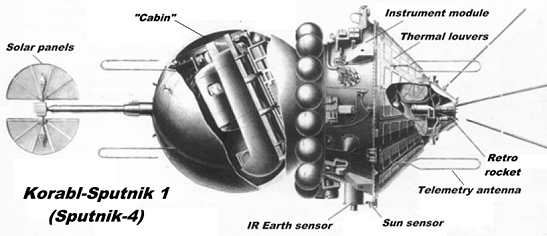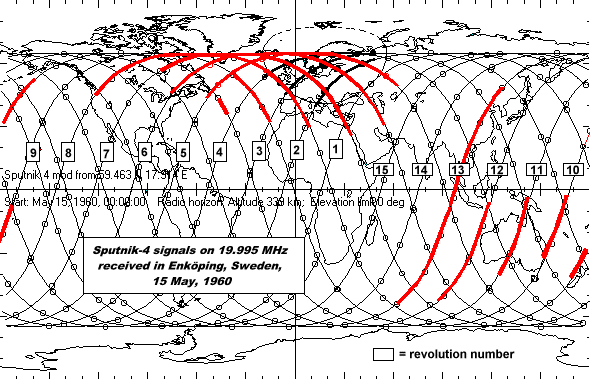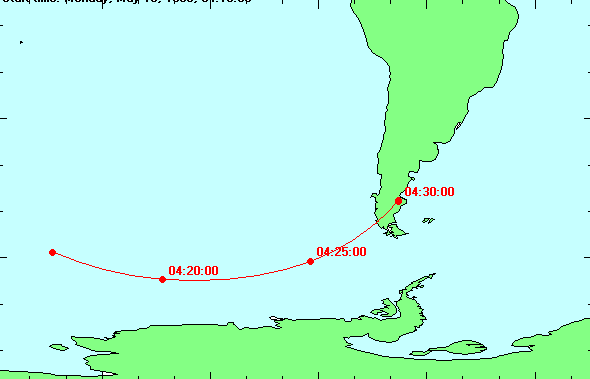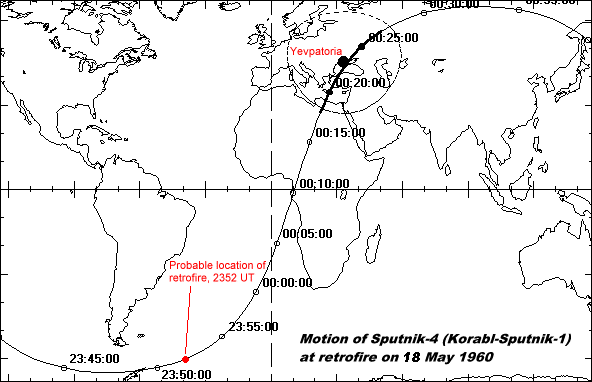The flight of Sputnik-4
Sven Grahn
Contents
Sunday
15 May 1960
Announcement
of the flight
I remember quite well the Sunday
morning when the news of the launch of Sputnik-4 was announced. It
really made big headlines and was seen as a first step to manned spaceflight,
despite the fact that TASS clearly stated that the spacecraft would not
be returned to earth. Early press reports were quite detailed based on
Soviet official announcements. The total mass of 4540 kg was astounding
and the airtight cabin was said to weigh 2.5 tons and containing a "dummy"
spaceman. It was also clearly stated that the "cabin" would be detached
on command and burn up upon re-entry. The orbit was given as having an
inclination of 65 degrees and an altitude of 320 kilometres (actually the
orbital altitude was 312-369 km).

The TASS communiqué
also gave the radio frequency of 19.995 MHz for the radio beacon which
also could be used for radiotelephone communications (See
below). The existence of solar panels on the spacecraft was also indicated
in this first announcement (see figure above).
The news was announced at
0425 UT on Radio Moscow five minutes before the first morning news broadcast
after Russian music and party songs had been broadcast. The TASS communiqué
was broadcast three times in succession so that nobody would miss its significance.
(1)The
spacecraft had probably been launched at 0000 UT. (8)
TASS also announced that
Sputnik-4 passed Paris at 0438 UT on 15 May.(3)
Of course, the significance of this was the fact that the summit between
U.S. president Dwight Eisenhower and Soviet leader Nikita Khrushchev was
taking place in Paris.
Radio observations
on 15 May 1960
UPI's monitoring station at
Bickley in Kent picked up signals at 0600 UT on Sunday 15 May 1960 on 19.995
MHz. This was on the spacecraft's forth revolution around the Earth. The
signal was described as "plingeling" (in Swedish) or the Morse letter
A with a purring sound at the end (Read here
about the character of short-wave signals from Vostok test flights and
actual Vostok flights). The Swedish telecommunications Agency monitoring
station at Enköping picked a strong CW signal on 19.995 MHz with doppler
shift at 0738-0757 UT on 15 May 1960.
(2)This
station picked up much more signals on 15 May and these are summarized
in the table and map below. Interestingly "antipodal" receptions were made
and the one on rev 12-13 was actually the strongest during the day. Antipodal
receptions were extensively observed during early
Soyuz flights.
Receptions of Sputnik-4
in Enköping, Sweden, May 15, 1960
|
Revolution
|
Time (UT)
|
 |
|
5
|
0738-0757
|
|
6
|
0911-0934
|
|
7
|
1045-1106
|
|
8
|
1212-1236
|
|
8
|
1319-1328
|
|
9
|
1400-1407
|
|
9
|
1452-1501
|
|
10
|
1507-1518
|
|
10
|
1533-1535
|
|
10
|
1622-1632
|
|
11
|
1749-1803
|
|
12,13
|
1920-1950
|
Monday
16 May 1960
Press reports said that Sputnik-4
passed near Paris at 0325 UT and straight overhead in Stockholm at 0500
UT 16 on May. At 0415-0430 UT on 16 May 1960 the Kettering
Grammar School picked up its first signals ever and they came form
Sputnik-4. Strangely enough the spacecraft was over the south Pacific during
this observation, see map below.

May 18,
1960 - retrofire
In the morning of Friday 20
May 1960 there were reports (6) that radio
observations in the UK and Sweden (Swedish telecommunications Agency monitoring
station in Enköping) showed that the retro rocket engine had started
at about 0300 UT on 19 May. The orbital period had increased from 91.2
to 94 minutes. According to (5) retrofire was
indeed planned for early May 19. The retro-rocket actually fired at 2352
UT om May 18. The map below shows the probable location of the retrofire
point. Really reliable orbital parameters are not available. Howveer, it
is quite evident that the ground track took the spacecraft over the ground
station at Yevpatoria.

TASS promptly announced that
the retro impulse was directed in the wrong direction causing the spacecraft
to enter a higher orbit instead of descending. TASS gave the new orbit
as 307-690 km and the period 94.25 minutes. (The RAE table of earth satellites
(7)
gives the new orbit as 290-675 km). The spacecraft finally re-entered on
15 October 1965.
Retransmitted
voice noisy and distorted
In the announcement of the retrofire
failure TASS described that the retransmission of voice signals through
the short-wave transmitter on 19.995 MHz had been made during the flight
but that the retransmitted signal had been noisy and distorted. This quite
interesting, because, presumably, the Soviet side wanted to avoid any speculation
in case Western tracking stations picked up strange sounds from the spacecraft.
The
reason for the retrofire failure
Prior to the firing of the TDU-1
retro engine the controllers at Tyuratam under the command of Boris Chertok
had detected problems with the infrared orientation sensor and wanted to
perform the retrofire using the backup system based on a solar aspect sensor.
However, the designer of orientation system Boris Rauschenbakh, refused
to go along and convinced Korolev and Keldysh, the president of the Academy
of Sciences. However, the primary system malfunctioned with known results.
As a result the IR horizon sensor was dropped for the manned variants of
spacecraft, but it was used on Zenit reconnaissance version of the spacecraft.
The
orbit of Sputnik-4 and subsequent flights in the Vostok program
The orbits of Sputnik-4 and
Sputnik-5 were quite different than those of subsequent flights in the
series leading up to the launch of Vostok-1. The low perigee of these later
flights permitted natural decay of the spacecraft within ten days, to provide
an emergency way of saving the cosmonaut in case the retrorocket failed
to fire. The orbital element set (in Two Line Element format) is given
below and the following table shows the orbits of Vostok test flights and
Vostok-1 itself.
Sputnik 4
1 00034E 60005A 60135.99241567000
.00000000 00000-0 00000-0 0 10
2 00034 64.8900 268.5663
0042419 63.0000 297.4325 15.76722300 00
Int.Nr
Satellite Incl Period
Apogee Perigee
==============================================================
60-005A
Sputnik 4 64.9 91.3
369.0 312.0
60-011A
Sputnik 5 64.9 90.7
324.0 297.0
60-017A
Sputnik 6 65.0 88.5
232.0 166.0
61-009A
Sputnik 10 64.9 88.4
230.0 164.0
61-012A
Vostok 1 64.9 89.3
315.0 169.0
References
-
Swedish
evening paper "Expressen", 15 May 1960, p.7
-
Swedish
evening paper "Expressen", 15 May 1960, p.6
-
Swedish
Communist Party daily "Ny Dag", 16 May 1960, p.6
-
Swedish
daily "Svenska Dagbladet", 16 May 1960
-
Asif Siddiqi,
Challenge to Apollo, NASA SP-2000-4408, Washington D.C., 2000.
-
Swedish
daily "Dagens Nyheter", Friday 20 May 1960
-
The RAE Table
of earth satellites, 1957-1989, The Royal Aircraft Establishment, 1989,
ISBN 0-9516542-0-9
-
Sergey
A. Voevodin's Reports

 Back
to Space History Notes
Back
to Space History Notes




